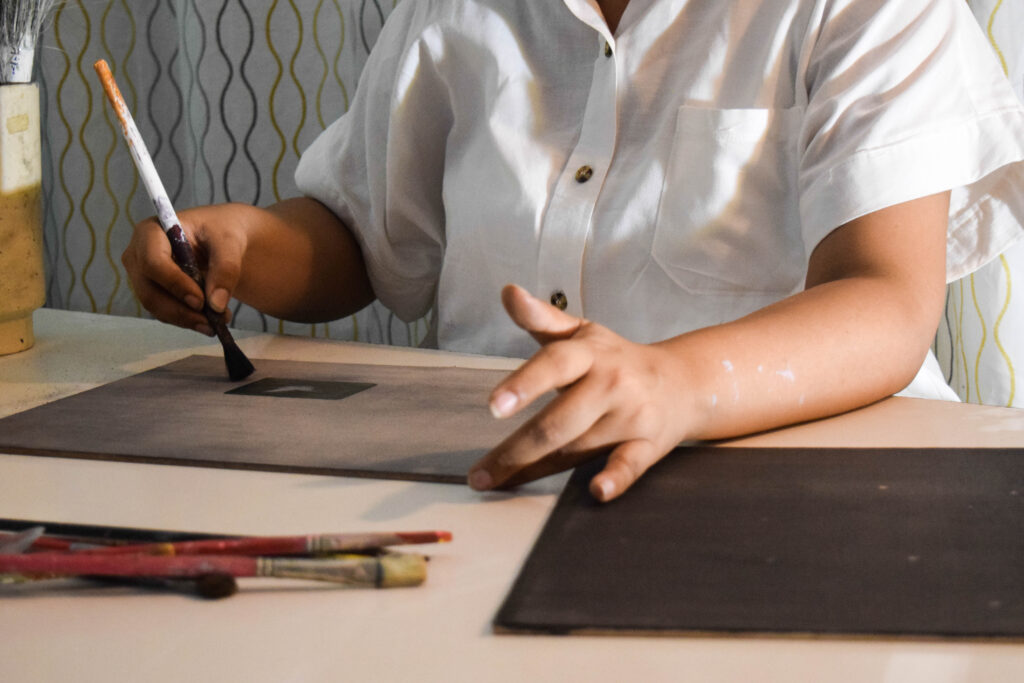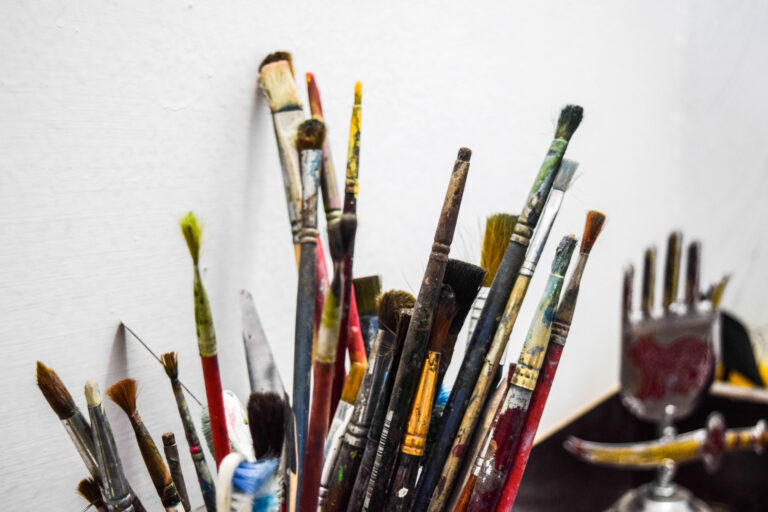
Asavir Nadeem
HZ: Your artworks have an otherworldly quality about them in the sense that they are like dreamscapes given form, could you talk a bit about the juxtapositions of the recognizable city elements and the organic forms that you have added to achieve these final images?
AN: My work and processes overlap. Since my process involves automatist mark-making, over time my mark-making cultivated a self-referential lexicon that can be deconstructed to reveal various recognizable elements – such as buildings, organic forms like rivers, mountains, hybrid creatures, and portals; all caught in various stages of metamorphosis and kinship. Those marks and textures were feeding into one another and creating labyrinthian spaces within spaces. As Susan Morris states, “As anyone who doodles knows, a line drawn inside a frame immediately demarcates a territory: foreground and background are implied. So, the way space behaves in my work is a little different and that extends into that dream-scape quality.It was an organic progression, therefore, for me to superimpose that language atop recognizable spaces- to magnify that experience of otherworldliness and worldbuilding, that feeling of being present yet disassociated and detached; of living inside an interlude of awareness where you are somewhere but are unable to ground yourself in its thereness – of daydreaming. Being caught between multiple realities and worlds and understanding that, that state of limbo can feel as real and loud as experiencing the “real world”.
HZ: Through your mark-making process you expose previously hidden vibrant hues, what do these streaks of colour add to the narrative that you are building in these pieces?
AN: The automatists emphasized ways to unlock the unconscious akin to improv in theatre: the ability to submit ourselves to darkness and to surprise ourselves and others by what is revealed at the moment. I think the darkness of my surfaces allows me to listen to and follow the journey my marks want to take instead of trying to control or ascertain their destination. When I started superimposing upon buildings, I wanted to also focus on something I read in Susann Morris’s paper, titled “Drawing in the Dark”, which elaborated on what it meant to leave a mark in space; how we shape the space around us just as the space around us changes us. I think the streaks of colour and light follow the same essence in my work. Scratching is like digging out and around spaces that are waiting to be revealed and constructed. It is paradoxical in nature. You are taking away to reveal and, in the process, you’re leaving upon and within the spaces you occupy and move through while also understanding that they leave their marks upon you. There is a symbiotic relationship between negative space and positive space similar to that present between light and darkness.
HZ: Water bodies are an important part of at least two of the pieces, do you find a link between the tempting crash of waves and themes of wanderlust, could you expand a bit on these links?
I think the fluid forms we may see in my work, be it water, wind, or other disintegrating forms all carry the essence of metamorphosis and shape-shifting. That quality enhances the experience of space itself. David Morris asks, “How can one examine, pictorially, the representation of space when one’s place within it cannot be found?” To me, this alludes to feelings of disassociation and daydreaming. I ask, what does it mean to travel through space and what does it mean to let space travel through you? How does it feel when you dissolve into your surroundings? In the Edge of Surrealism, Roger Caillois relays how different organisms across natural kingdoms have this desire to “succumb to the lure of material space… to disperse everywhere, be within everything” to penetrate each atom, to descend into the heart of the matter- to be matter.”
Similar to that, I think the elements in my work are like characters, travelling and carving out their own path while chasing this want to experience and become everything. For me, the fluid bodies in my work are not just water bodies but they are atoms and molecules, they are debris, and they encompass foliage, limbs, tissue, and also the wind. These fluid forms and organisms captured in various states of metamorphosis draw links to the psychological and emotional feelings attached to feelings of wanderlust and time-travelling through space.
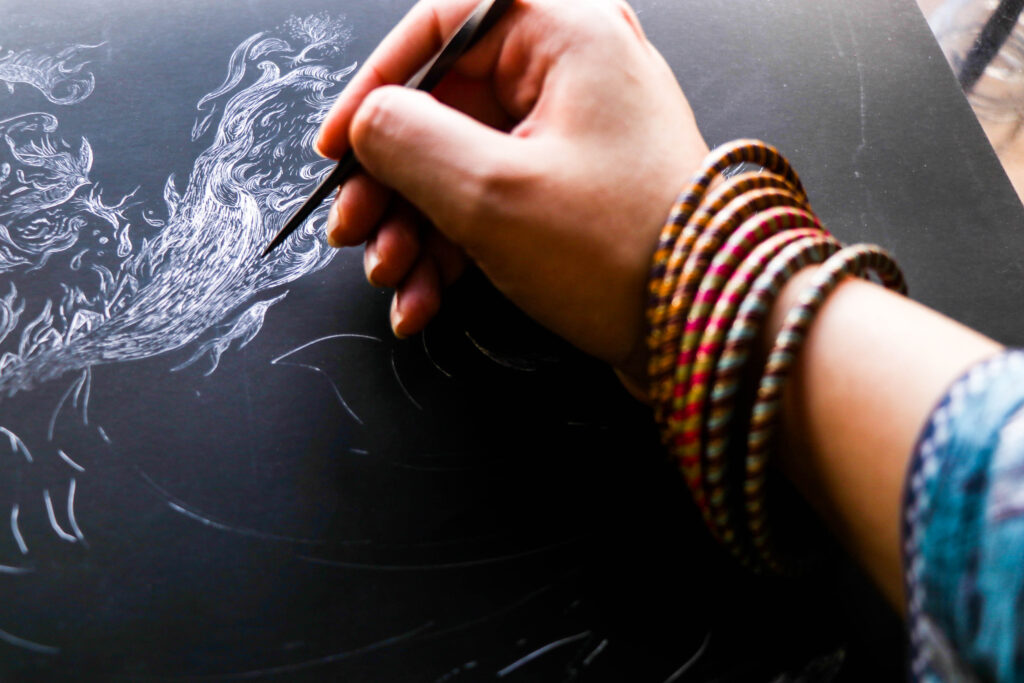
AN: Talking about the ethereal animalistic forms that inhabit these worlds what is the symbolic importance of these and other fantastical elements that you have depicted in these pieces?
I’d like to refer to Gustave Flaubert in “The Temptation of St Anthony”, where Flaubert discusses how the biological structures within animals, plants, and living organisms are fundamentally similar. For eg., pebbles may look like brains or how tree branches may look like hands. There is an interpenetration within the three natural kingdoms. If we observe nature, we see that overlap expanding over the realm of the magical and the mystical.
It was therefore very organic for me to not only create these mysterious, fantastical hybrids and forms but to make them in a state of fluidity and flux. To find them in organic and abstract textures and patterns and inkblots. Oftentimes, I create unfamiliar creatures and forms out of marks and textures and later find an uncanny resemblance between them and real organisms; such as deep-sea creatures or bacteria. There is an obvious connection between our unconscious mind and the dark recesses of the natural world.
I feel a kinship towards these organisms and their unique experience of space where they often try to assimilate into the spaces around them through mimicry. The same feelings are what we describe as disassociation, where you feel like you cannot set up roots. You have the freedom of being untethered but are still physically bound by structures that exist within your surroundings.
HZ: What do you want the viewers to take away as they experience the pieces?
AN: I invite them to enter these spaces and find hidden, familiar objects and references of their own volition. To extract and find their own space within these drawings. They will see as much as they want to see and be seen as much as they’d like to be seen. I hope they get a similar sense of intrigue and curiosity while exploring these spaces as I did while creating them and I hope they allow themselves to be lost in these worlds and let these worlds leave a mark on them.

Ayaz Memon
HZ: The way in which you have masterfully used the wistful looks of the human characters in your paintings, underlines a unique longing. What is this longing for do you think? and what is your association of these figures and how do they tie themselves to your own self?
AM: These characters are concepts that are a part of my very soul and they speak within the inner crevices of my heart. I always observe life, freedom, peace, and nature around me in great abundance and through my practice, I use myself as the catalyst to depict these visuals. The affective quality of the pieces and the expressions of different characters, and the mood they create in the viewer’s mind stem from me. The characters that you see within my pieces are in essence an extension of my own psyche.
HZ: Could you expand on the symbolism within your use of animal characters in the paintings, how do you see them aligned with the themes of wanderlust?
AM: Birds or animals are elements of the beauty present on the earth that we are witness to. The world to me is a home, and every object is part of the tapestry of this world bounded by bonds of kinship for we are all created by the same maker. I particularly am fascinated by animals and birds, because whenever I see them flying carefree in the waves of the wind I am overcome by feelings of happiness. The birds flying in the sky with their seemingly innocent emotions obscure the passion needed for surviving this harsh life and thus offer a rich contrast and act as guides to the human figures in the pieces. In the childlike play of animals, I relate to my own feelings of a want for freedom and a desire to return to nature. To me, these animals and floral elements collectively symbolise the life that inhabits the desolate landscape of the mind which within the confines of city life is so far removed from the nature to which it belongs.
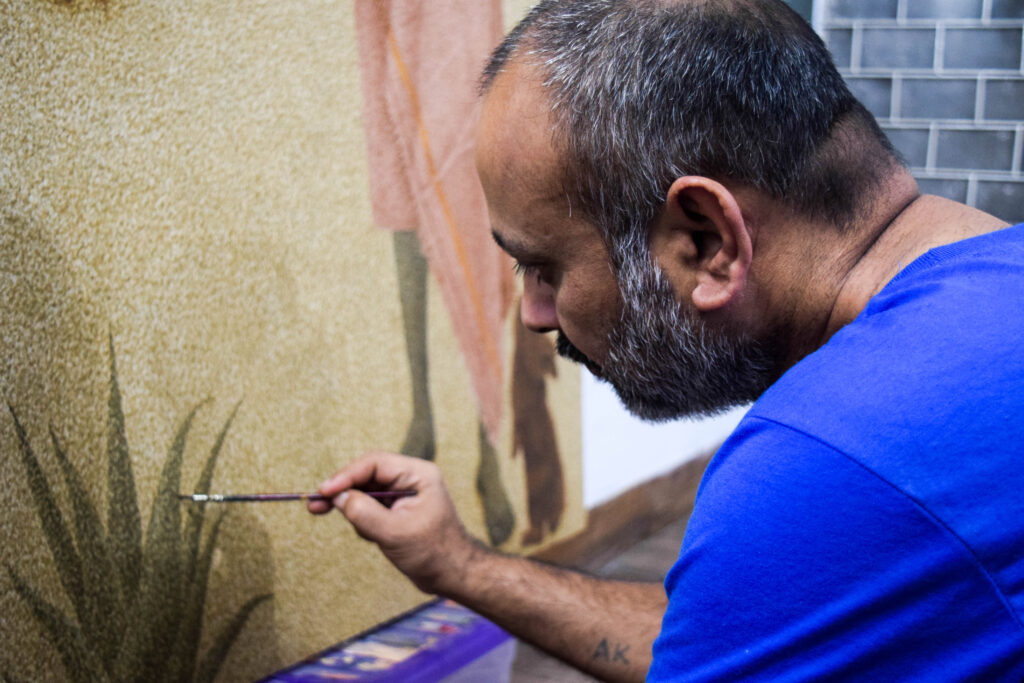
HZ: Looking at your vibrant yet sedate colour palette and the fine pointillistic brushstrokes, it is clear that you hold a certain mastery over this style, Could you explain how it aids you in addressing your subject matter?
AM: Throughout the years since I began my art practice, I have arrived at these tiny brush strokes, I use these tiny points of colour to create paintings that convey a sense of calm hidden in a flurry of movement as the eye moves from point to point it encapsulates how I too perceive my subject matter. In this slow and repetitive process of mark-making, I follow in the style of painting made famous by the impressionists called divisionism or pointillism, I am intrigued by this visual practice as rather than blending colours together on my palette, dabbed tiny strokes or ‘points’ of thin colour on canvas, collectively depict a visual showcasing an infinity of colour strokes and gradually work towards building a narrative.
HZ: These lands that you are recreating through your pieces have a desolate quality about them, why do you think that is ? and does it have any bearing on how the viewers should approach your work?
AM: The backgrounds of my paintings are seemingly desolate yet to me are lands of peace which are made by my imagination, these places are one of the limitless possibilities. It is my hope that they convey a message to viewers about love and peace that is attainable if only we look to the future that is most often out of view.
HZ: What do you want the viewers to take away as they experience the pieces?
AM: My work is about the journey of life, how we can live safe and sound on our earth because we all are one thing that is called life, so everyone and everything is connected with one another and so painting is essentially them observing themselves, and so they can read the visual language I have made use of in accordance to their own perspective.
Irfan Channa
HZ: Your pieces have a certain ethereal quality about them, ranging from the subject matter to the way in which you choose to depict it, could you explain as to how you think your distinct art style works so well towards conveying themes of wanderlust?
IC: I believe my work is based on the moments I capture during travelling from too & fro, or you could through my practice I stand witness to the roadside happenings I am privy to when I’m on the move from Lahore to my hometown, or my hometown to another place. I have therefore developed my art style by collecting memories and chasing wilderness. While on my travels some moments stand out and sometimes I make use of film and photography to gather all the visual information I need for my work.
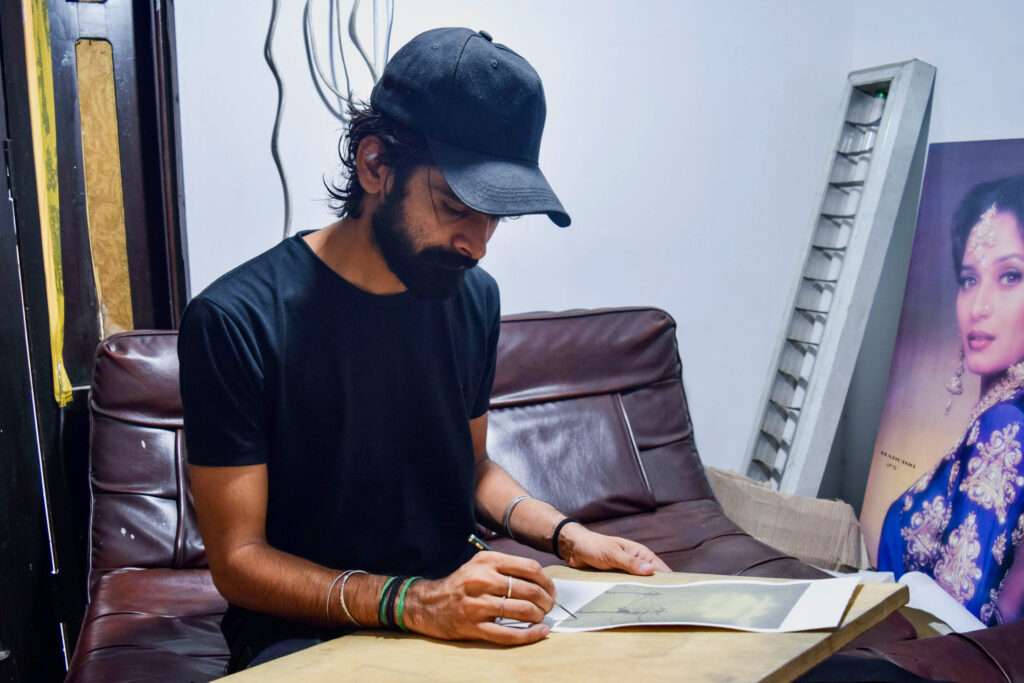
HZ: The piece with the boatman seems at once calm and yet belies a scene full of motion, a snapshot of a journey it is reminiscent of mythical journeys undertaken by the heroes and heroines of Nordic sagas and Greek Mythos, could you explain a bit about the characters and what they represent for you and most importantly how you wish for them to be perceived by your audience?
IC: For me, the most important thing is that, whatever I draw, paint, sketch, or make, there should be room for in my expression for everyone’s perception. Frankly speaking, during creating these visuals, I enjoy the method and the memory that I collected from the spaces I visited, the things I noticed, and the scenes I captured.
HZ: The piece with the cloud and cable poles talks at once of nature and urbanisation, to me the scene talks about escape and freedom from confinement, could you expand on how these natural elements relate to the themes of wanderlust that you depict in these works?
IC: When you move around the city, or travel through various modes and sit on the window seat inside a train or bus, etc, you see the green grass on the roadside, and when you look at the sky, you see there are trees between your sky and your eye, sometimes there is glass window between you and your sky and more other than not, there are poles and urbanscape between your sky and your eye and yet you keep looking at the sky regardless of these objects and other such distractions. Through my art, I capture that. I used to keep noticing these, tiny minuscule ignored elements while travelling and decided to depict these in the work.
HZ: The sepia tones of the piece play a very important role in the ambience created within the pieces, for me, this colour palette evokes feelings of nostalgia could you explain the significance of these colours and how you see them?
IC: The question that I ponder often is ‘How is the visual created within one’s memory?’ such that they are imbued and vague and yet when I paint them, I feel like my brain adds much-needed clarity and focus to the piece. So I make sure that the visuals created retain their ethereal charm, while also being articulated and delicate enough to create another memory in the mind of the viewer. This sepia-toned palette helps me in conveying such nostalgic feelings through my work.
HZ: What do you want the viewers to take away as they experience the pieces?
IC: My work is a travelogue of sorts, it depicts the wilderness of my hometown to the urbanscape of major cities. I enjoy creating these visuals and the significance these images hold for me but I want the viewer to see these as portals into their own unique personal experience of travelling as everyone is so frequently moving from here to there. For me, life is a journey in itself and these visuals aren’t just visuals but a collective memory that we share and experience together while completing the journey that we must all undertake from this place to our eternal abode.
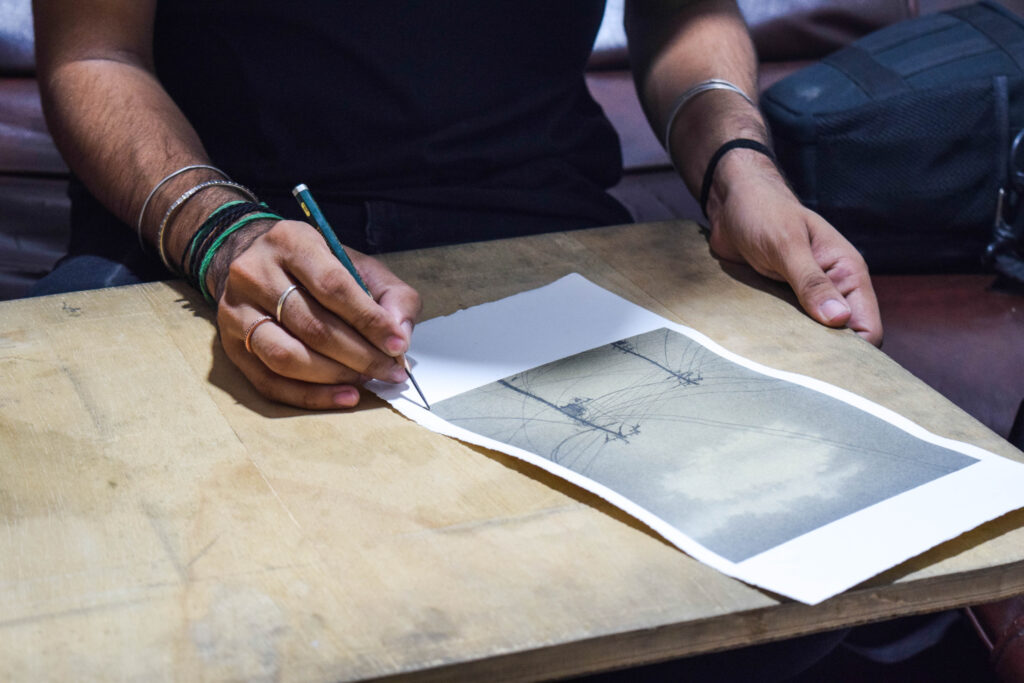
Khadija Rehman
HZ: Intimate communal spaces figure prominently in your pieces, coupled with your vibrant colour palette these offer a unique juxtaposition as you depict themes of wanderlust within these serene settings, could you expand a bit on these connections and your approach to the theme?
KR: I imagine the spaces I create to be purely liminal. They are these transitory, dreamlike settings, surreal and otherworldly. The wanderlust in my work has less to do with real-world meanderings and has more to do with the wanderings of the mind. Through a patchwork of colour and pattern, I transport my characters through and beyond time making them travel to and exist in nostalgic spaces of the mind. Linear time does not exist in these spaces, and many versions of the same person can exist at the same time. These travels have a lot to do with introspection and connection, both as a self and as part of a community.
HZ: The figures in these pieces whether they be of women or of various birds seem to be longing for something, there seems to be a stillness before taking to flight, could you expand on the use of the characters depicted and their significance to you?
KR: I like to think there is a massive underlying current of yearning in my paintings. In observing myself and other South Asian women around me, I often stumble upon the feelings of longing. A yearning for safe, female spaces, bodily freedom, or just simply a yearning to exist as one is without the conformity of gender roles. I love that you have used the word stillness here – the settings I create are like theatrical scenes to me, with women from the past and the present caught in everyday acts of intimacy and existence, away from the world. The strange birds are witnesses, or guardians, flitting between this dream world and the real one, as a connection between the viewer and the characters is formed. The placement of the birds is also key – for instance, sometimes the birds will be perched on top of one another as if the universe is glitching. Sometimes they signify mortality or might perch upon a character’s head as if choosing them, or warning them.
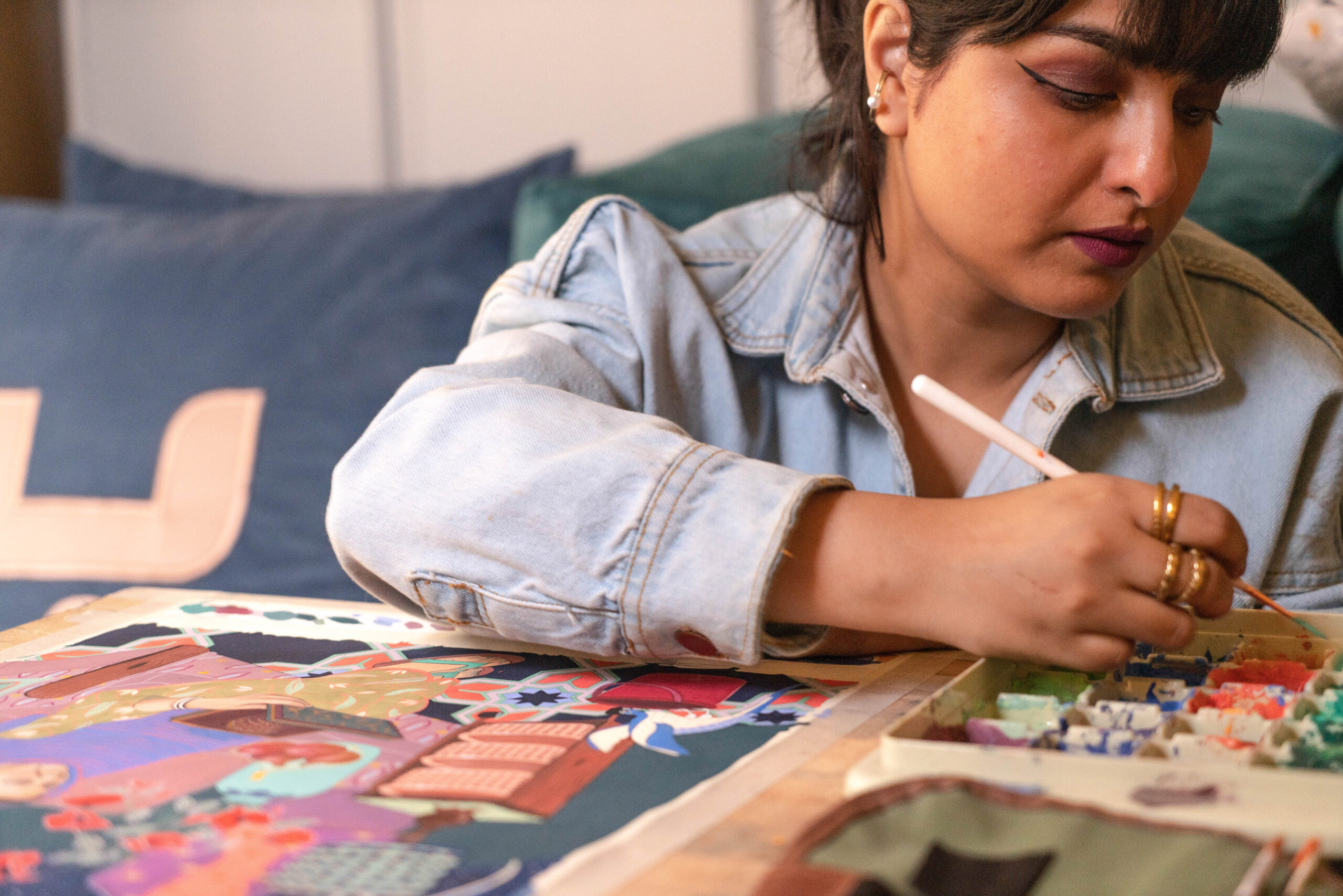
HZ: The pieces are full of mesmerising tiny details and objects; Sometimes fruits, sometimes flowers, and sometimes radio sets peeking through the work, could you expand on the significance of these objects and how the viewers might interpret these elements?
KR: The natural elements in my work are a nod to mortality. I do bring the dead back in a way, using old and new photographs to bring unlikely characters together in visually familiar ways. The flowers and other organic elements are larger than life and almost neon in their vibrancy as if they were at the peak of their lifetime within the moment I have captured. The blossoming, blooming nature of these organic elements also connects to the uniquely enthralling experience of being a woman. Objects such as radio sets and old sofas, brightly coloured chappals and wonky lamps all contribute to the nostalgia I am trying to create. These are objects that are found in abundance in most South Asian households, and immediately bring to mind a thousand memories and anecdotes.
HZ: The moon and the night sky hold centre stage in these worlds within the pieces; could you expand on the importance of such late-night ruminations as the ones the figures are engaged in within your artworks?
KR: The night has always had a magical quality about it that daytime just cannot match. Nighttime is the time of secrecy, of introspection and of clandestine meetings. In most folklores too the night is when lovers are torn apart, or reunited, or pine for one another in two different parts of the world. It is as if the night is a character in itself, slumbering in the background as these women come together in these secret, untainted spaces and embrace their womanhood. The moon is most magical and makes so many appearances in a lot of poetry, rife with a unique metaphorical resonance. Sometimes a character I create will face the moon as if looking it in the eye in mutual acknowledgement. Sometimes I’ll put two moons in the same sky, to signify the surreality of the space and the overlapping nature of non-linear events. As the moon waxes and wanes in my work, it gives its light to these women and also borrows from their radiance.
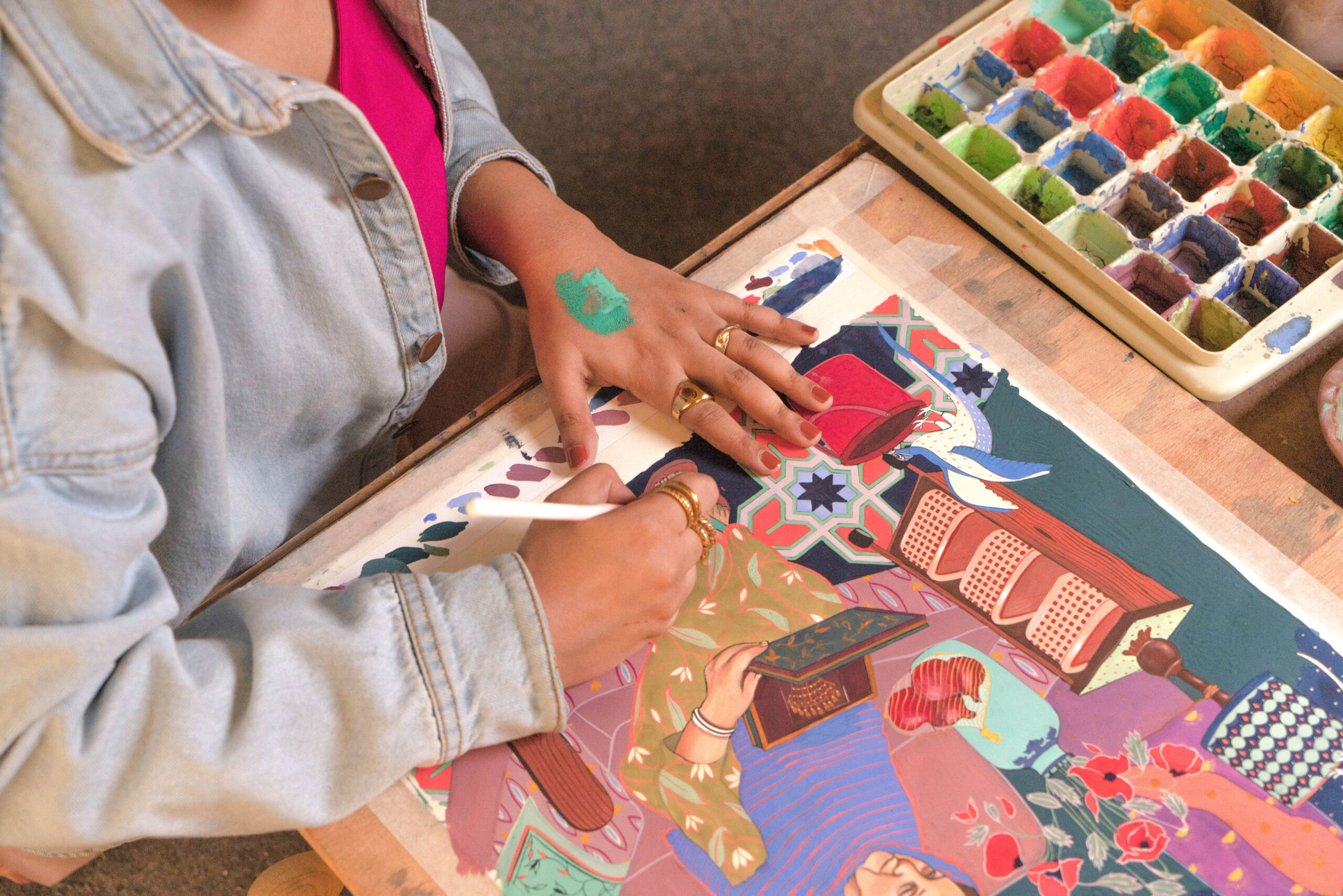
HZ: What do you want the viewers to take away as they experience the pieces?
KR: I never really want to assume on the behalf of the viewer or dictate their experience. I can say that when I create paintings, I think of the magic in the ordinary, the fragile, almost delicious longing of nostalgia, and the primal, unfettered joy and ache of being a woman alongside other women. I hope a glimmer of what I feel makes it through to the viewer.
Sameen Agha
HZ: Your artworks have a wistful, blurry quality about them, this is especially conveyed via your choice of subject matter; could you expand as to how you associate butterfly’s wings with the themes of wanderlust?
SA: A traveller that is clearly, weightless to me creates a sense of wonder, a sense of isolation. As we wander through life, we desire to explore and shine our light through each and every experience. We’re all lonely beings that will live, explore dust, die and eventually become more dust.
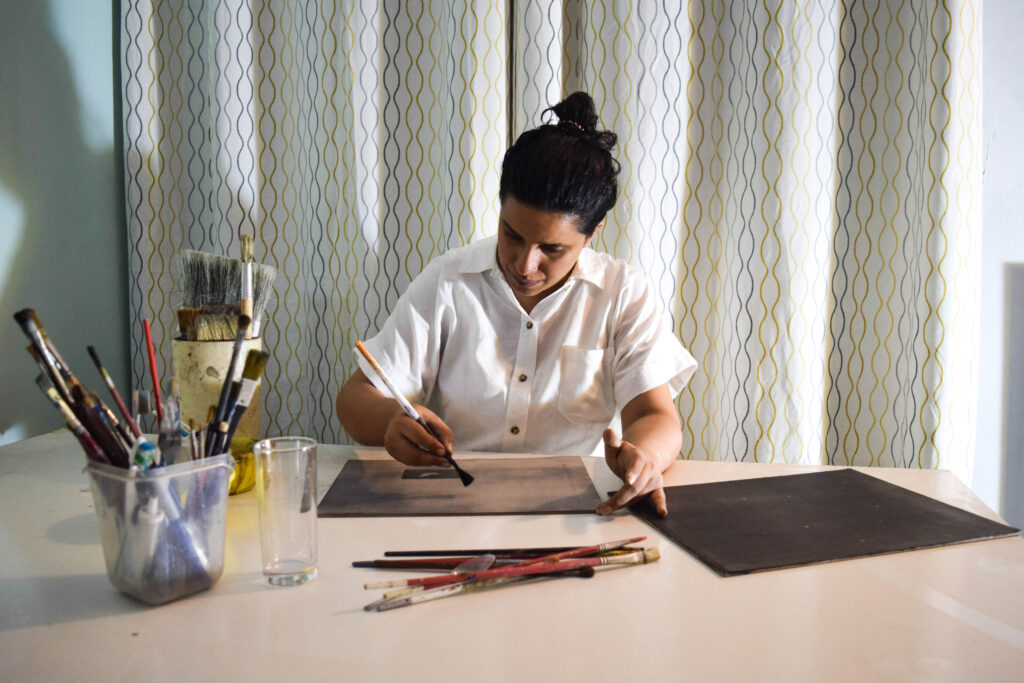
HZ: The piece with the bright clouds and its contrasting window into the butterfly’s landscape at once talks about both freedom and confinement; could you explain how you relate this juxtaposition to wanderlust as coloured by the perspective formed by this piece?
SA: Confinement does not signify the tortured state of the individual but signifies the freedom to choose and assign one’s self with chosen boundaries. For me, it’s like choosing where your mind wanders in/to and so that’s exactly what I’ve chosen to reflect upon through this piece.
HZ: You have used in these pieces a very subtle and sensitive colour palette with bright pops of colour sprinkled throughout; could you explain how you see these working towards conveying the content of the pieces?
SA: For me what I’m recreating are constellations of imprisonment. The birdwing is sort of stuck between the constellation in a sort of ethereal space. For me, this composition and placement give a feeling of helplessness in a way but the wide-open sky gives a sense of hope at the same time and so a unique juxtaposition is created.
HZ: What do you want the viewers to take away as they experience the pieces?
SA: My works are always open to different interpretations and that’s what I enjoy once the work has left my studio. As far as I can manage I attempt to grasp my viewers’ attention and in their engagement with my pieces I get more interested in knowing what/how they make them feel.
